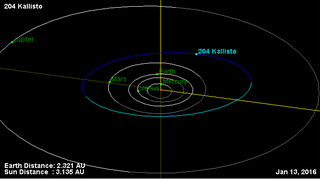
Vincentina is a fairly large main belt asteroid.

Kallisto is a fairly typical, although sizeable Main belt asteroid. It is classified as an S-type asteroid. Like other asteroids of its type, it is light in colour. It was discovered by Johann Palisa on 8 October 1879, in Pola, and was named after the same nymph Callisto in Greek mythology as Jupiter's moon Callisto.

Hedda is a sizeable Main belt asteroid. It is a C-type asteroid, meaning it is primitive in composition and dark in colour. This asteroid was discovered by Johann Palisa on October 17, 1879, in Pola and was named after Hedwig Winnecke, wife of astronomer Friedrich A. T. Winnecke.

Prymno is a somewhat large Main belt asteroid. It is classified as a B-type asteroid and probably has a primitive composition not unlike common C-type carbonaceous asteroids.

Dresda is a typical Main belt asteroid. It belongs to the Koronis family of asteroids.

Anna is a typical Main belt asteroid.

Tirza is a fairly sizeable, very dark Main belt asteroid.
Caprera is a minor planet orbiting the Sun.
Virtus is an 86 km minor planet orbiting the Sun. It was discovered by Max Wolf on October 7, 1902. Its provisional name was 1902 JV.

Sigune is a minor planet, specifically an asteroid orbiting primarily in the asteroid belt. Like 501 Urhixidur and 500 Selinur, it is named after a character in Friedrich Theodor Vischer's then-bestseller satirical novel Auch Einer.
Laodica is a minor planet orbiting the Sun.

Iolanda is a minor planet orbiting the Sun.

Nassovia is a minor planet orbiting the Sun. It is a member of the Koronis family of asteroids.
625 Xenia is a minor planet orbiting the Sun. It was discovered by August Kopff in Heidelberg, Germany, on 11 February 1907. The name may have been inspired by the asteroid's provisional designation 1907 XN.
633 Zelima is a minor planet orbiting the Sun in the asteroid belt with a magnitude of 10.7. The name may have been inspired by the asteroid's provisional designation 1907 ZM.
635 Vundtia is a minor planet orbiting the Sun - though this claim has been disputed.
663 Gerlinde is a minor planet orbiting the Sun.
768 Struveana is a minor planet orbiting the Sun. The asteroid was named jointly in honor of Baltic German astronomers Friedrich Georg Wilhelm von Struve, Otto Wilhelm von Struve and Karl Hermann Struve.
6144 Kondojiro (1994 EQ3) is an asteroid discovered on March 14, 1994 by Kin Endate and Kazuro Watanabe at the Kitami Observatory in eastern Hokkaidō, Japan. It is named after Jiro Kondo, a Japanese Egyptologist and professor of archaeology at Waseda University.
2021 LL37 is a large trans-Neptunian object in the scattered disc, around 600 kilometres (370 miles) in diameter. It was discovered on 12 June 2021, by American astronomers Scott Sheppard and Chad Trujillo using Cerro Tololo Inter-American Observatory's Dark Energy Camera in Chile, and announced on 31 May 2022. It was 73.9 astronomical units from the Sun when it was discovered, making it one of the most distant known Solar System objects from the Sun as of May 2022. It has been identified in precovery images from as far back as 28 April 2014.










